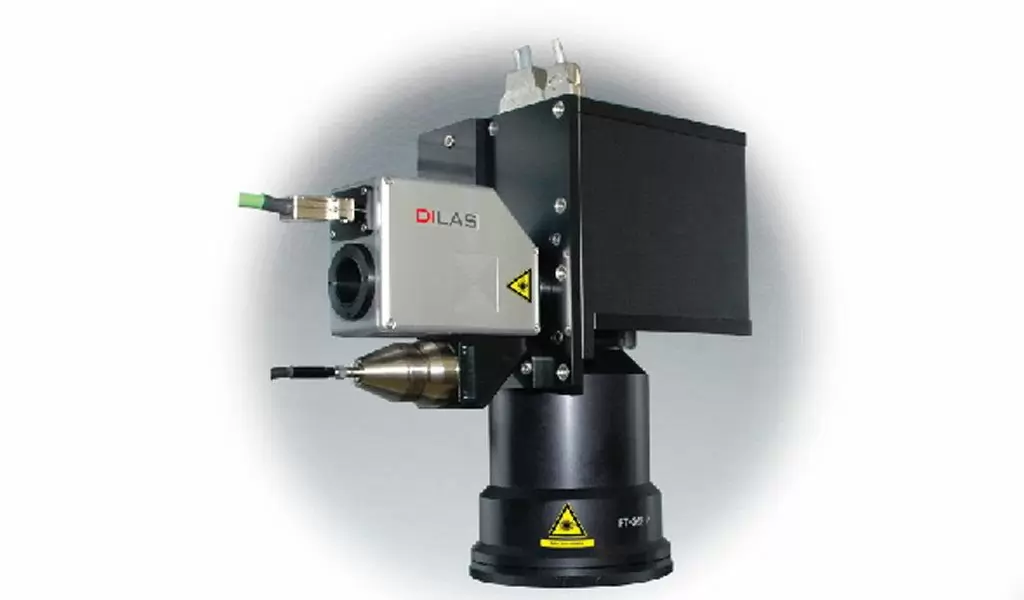In addition to traditional welding methods, the laser melting process of plastics or polymers has developed into a mature welding method in many industries. This cleaning process offers the user many advantages and can facilitate the melting of sensitive components. Laser melting of polymers refers to a transfer process in which the components to be welded are overlapped. As shown in Figure 1, the upper connecting part delivers the laser radiation and is absorbed and softened by the lower part. The transfer of heat also melts the upper layers and creates welds (forces) between the parts. Therefore, the laser transmission characteristics of the parts to be welded are important in this laser melting process.
Diode lasers typically used for polymer melting emit between 800 and 1000 nanometers. Most non-pigmented thermal polymers have good laser transmission properties in this wavelength range.

An absorbent material such as carbon black is added to the base material, and special additives can also be incorporated into the blend material. Various color combinations (from clear to pale) may absorb laser wavelengths, or strongly absorb and transmit laser wavelengths at the same time.
The Advantage Of Laser Welding Process
Most laser welding methods can largely compete with traditional welding methods and provide many process advantages. It is worth mentioning that the control it exhibits over the energy input to the joint area is a significant advantage for many assemblies and assemblies. Typical advantages can be summarized as follows:
● true sealing;
● Minimal mechanical and thermal stress;
● Stable, reliable and very flexible process flow;
● No particles and debris at all;
● Formation of internal protective seams;
● Minimal melt injection;
● No additional materials are required;
● The quality and durability of the solder joints are very good.
Quality And Process Control
As with other joining methods, there are also quality control issues in the laser melting process. How exactly does the melting process confirm quality and/or differentiate good parts from poor ones? How exactly can you minimize the number of out-of-spec parts with the right quality and process controls?
One of the quality assessment methods (also used for other welding methods) is to measure the variation of parameters along a set laser melting path. This melting path can be used to rapidly drive the laser beam around a fixed, closed melting path using a scanning galvanometer.

The laser beam is rapidly deflected towards a programmable melting profile that melts almost simultaneously. By gently pressing the assembled components together using a mechanical clamping device, the molten material collapses to a defined distance and can be measured. If the molten part exhibits compatibility and weldability, then this collapse can be considered a good weld. If this parameter is not met, the weld seam may not be up to standard and the part may be scrapped as defective.
Another way to assess the quality of laser melting is to use a remote pyrometer to measure the molten material during the melting process. The processing head with integrated pyrometer enables rapid control of melt temperature and detection of melt defects. The advantages of using temperature control in the laser melting process are obvious, especially when the optical properties of the welded parts show some non-uniformity. Typically, this inhomogeneity occurs when these parts are reinforced with glass fibers. For example, these non-uniformities can be offset and compensated for using automatic laser power control to maintain the desired temperature.
An increase in temperature information may be indicated when the pyrometer control fails to compensate for a defective weld (eg, caused by a contaminated part or a poor or broken contact between two parts). Likewise, a pyrometer will detect when the desired melting temperature is not reached; (due to insufficient laser power). If the upper and lower temperature limits of the software defined range are exceeded, the affected part may be considered non-conforming.
Polymer Melting
Currently, the laser melting process of polymers has been increasingly used in a variety of different industries and is replacing many traditional joining methods. For example, in the field of medical device manufacturing, cleanliness is an absolutely mandatory requirement.
In particular, laser melting technology is widely recognized in the automotive industry supply chain. Auto parts are often equipped with sensitive electronic components or controls and contain liquids. In these and other similar cases, the fusion of laser beams is the ideal means of choice, and in combination with process control, diode lasers will continue to penetrate more applications in the future.
Melting Of Transparent Polymers
Recently, the melting of transparent polymers often requires the use of relatively expensive special absorbents and the addition of process flow to the equation. However, the use of higher wavelength lasers has eliminated the need for absorbers in many transparent polymer melting applications.
Lasers with higher wavelengths are used in the melting process of transparent polymers, and the interaction of such lasers with polymers is different from that of conventional lasers with wavelengths of 800–1000 nm. Part of the laser energy is still transmitted through a transparent thermoplastic material, but the part still absorbs slightly in this wavelength range. The energy absorbed is sufficient to heat the polymer in the melt zone and produce the desired result.
It is well known in the laser industry that laser energy is absorbed on every surface of the polymer being melted. Typically in these applications, absorption occurs on four surfaces: the upper surface, the two joint surfaces, and the lower surface. Since the joint interface is made up of multiple planes, most of the absorption that occurs during welding of transparent polymers provides a perfect environment for efficient melting of transparent thermoplastics without the use of absorbing additives.
